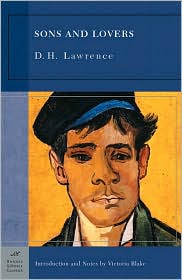Note: Modern Library has ranked this book #9 on their list of 100 Best Novels of the 20th century.
“I can’t physically love you, any more than I can fly up like a skylark.”
In what is con sidered to be D. H. Lawrence’s most autobiographical novel, Lawrence’s main character, Paul Morel, is a frail, artistic boy, having more in common with his mother than with his coal miner father. Paul’s mother had some education before she married the once-attractive Walter Morel, but he eventually succumbed to alcohol and a bleak life in the pits, and Paul’s older brother became the mainstay of the family. When he left for London and later died, his mother transferred her dependence from him to Paul.
sidered to be D. H. Lawrence’s most autobiographical novel, Lawrence’s main character, Paul Morel, is a frail, artistic boy, having more in common with his mother than with his coal miner father. Paul’s mother had some education before she married the once-attractive Walter Morel, but he eventually succumbed to alcohol and a bleak life in the pits, and Paul’s older brother became the mainstay of the family. When he left for London and later died, his mother transferred her dependence from him to Paul.
Written in 1913, the novel was shocking at the time, dealing as it does with an unhealthy relationship between mother and son, leading to the son’s subsequent inability to love women his own age. Having only scorn for her wayward and irresponsible husband, his mother needs Paul for emotional support. When Paul begins to develop a love for Miriam Lievers, a neighbor with whom he has been close friends since childhood, his mother becomes upset and more possessive, but eventually Paul’s relationship with Miriam becomes sexual. Miriam is a “spiritual” girl, and Paul comes to believe that even though Miriam has “given” herself to him, she does not love from an inner need, that at heart she is “a nun,” and that her “passion” is more dutiful than real. Since he himself is still tied to his mother, emotionally, his own ability to love fully is also compromised.

His next relationship, with Clara Dawes, a married woman separated from her husband, is far more passionate, but Clara is also far more liberated than Miriam, and she demands an emotional commitment from him in return. It is not until his mother’s death, however, that Paul realizes the extent to which his mother has truly controlled his heart and soul, leaving him far more bereft than is normal for loving sons.
A novel which probes the inner psyche of Paul Morel, Sons and Lovers is a novel which speaks directly to the modern reader, eliciting both sympathy and empathy as Paul tries to become his own man. Lawrence’s ability to tap into universal feelings and needs elevates this novel into a sensitive study of love in all its forms, not just in the case of Paul Morel, but on a deeper, grander scale. Though the novel is almost a hundred years old, it is as fresh and rewarding to read today as a contemporary novel, even when one considers the mores and prohibitions of that time period. Lawrence, ahead of his time, has created one of the enduring classics of English literature, one which supersedes time and place.
Notes: The photo of the author and his mother is from http://www.kathleenjones.co.uk/
Also reviewed here: LADY CHATTERLEY’S LOVER and WOMEN IN LOVE
